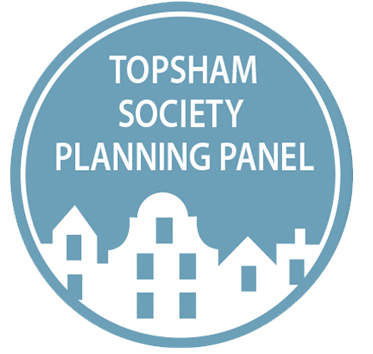
THE EXETER PLAN 2020-2040
CONSULTATION RESPONSE BY THE TOPSHAM SOCIETY-TOPSHAM COMMUNITY ASSOCIATION PLANNING PANEL
Members of the Panel attended the ECC exhibition at Matthews Hall, Topsham on the 20.10.22, have read the online Policy Statements and would make the following response.
General
The Panel welcome the thrust of the Spatial Strategy and ECC’s reversion to a commitment to concentrate development close to the City Centre (reminiscent of the Urban Renaissance of the previous government) including provisions of high quality homes at optimal density, served by sustainable transport, on Brownfield land. The Panel would hope that this signals a move away from the wholly unnecessary, low density suburban exploitation of the green fringe of the city that has occurred in recent years, due the well documented policy vacuum. This has overrun communities such as Topsham.
The Panel are disappointed that the Greater Exeter Strategic Plan (GESP) failed to advance and would question if without co-operation between authorities, Greater Exeter beyond the City boundaries, will become a dumping ground for surrounding LPA’s to achieve their allocations, whilst imposing ever greater strain on resources in and around Exeter.
Housing/Use of Brownfield Land
The Panel note the proposal for 6200 additional residential units and would ask for ECC to assure that this is a reliable assessment, given the calculation methodologies reliance on market generated demand figures.
It is noted that a significant proportion of proposed housing allocation is in Flood Plain areas such as Marsh Barton and Water Lane and is therefore dependent on overcoming flood risk constraints. It may therefore, prove undeliverable. This could place the overall housing provision strategy in jeopardy and throw the city back into the hands of developers intent on developing the green fringe again.
The council has the great advantage of owning large amounts of building stock in and around the City Centre and should take a far more proactive role in redevelopment, reuse and intensification of its own buildings, so as to lead from the front. City centre construction fits particularly well with the objectives set out in the draft plan – particularly sustainable transport, 20 minute communities and the natural environment. ECC should engage with creative designers and developers to find improved use for often under-used over lower floor commercial premises and “air rights” type sites (similar to the currently unimplemented proposals for Thomas Moore’s building in Fore St).
The Council need to more clearly specify how its proposals for mixed use areas integrating housing with commerce, could realistically optimise the use of such land, not just displace commercial and employment activities.
Post pandemic, the council also needs to step up policy options to repurpose redundant commercial buildings.
Given that the current national housing shortage is substantially driven by the falling occupancy rates of dwellings, the plan fails to capitalise on the benefits of multi generational housing/semi independent studio type accommodation within family housing and its potential to boost household occupancy/reduce housing demand, by genuinely creative design of new (and adaption of existing) family housing units.
Topsham Housing Sites
Whilst the refusal to consider allocation of the Mays Field area of Topham (sites 98/99) is welcomed and the Panel supports the proposal that 85% of new housing should be located on inner city Brownfield land, it is dismayed that most of the remaining 15% will be Greenfield development on the northwestern fringe of Topsham (sites 91-94). Given the saturation of the fringes of the town and ECC’s failure to maintain and adapt its previous LS1 policy position on the Topsham gap, the sacrifice of this remaining area is unwarranted. As pointed out by the Topsham 20 Campaign in their submissions, ECC’s criteria (non technical Summary Appendix D and page LUC15) for allocation of these sites is highly questionable. These sites should be maintained as green space to buffer the rural idyll of (west) Newcourt Road, to maintain its lane like environment in the way that the careless streetscape design of the recent RBL and Strongvox developments failed to achieve and avoid it being visually overwhelmed by the Clyst Rd development to the North of the Rail line.
Resisting Speculative Housing Applications Prior to Adoption
As the plan is unlikely to be adopted until 2025 and that land speculators will almost certainly seek to force approvals before the Plan comes into force, ECC must take necessary action to protect these areas until due process of the Plan examination and adoption, takes place. In this respect, ECC/DCCH must resist any intensification of traffic along Newcourt Road, Denver Road and Exeter Road, requiring any proposed development in these areas to be accessed from the Newcourt Estate via the Newcourt Road M5 bridge and the now overgrown original line of Newcourt Road to Admiral Way. This must be coupled with developing traffic management and green transport proposals that will form the backbone of any S106 contribution requirements.
Climate Change
The Panel supports the policy direction suggested in “Climate Change” and its proposal for a Zero Carbon City by 2030, but is disappointed that no reference is made to the impending monumental challenge of retrofitting the city’s existing building stock, which is likely to have profound visual implications on neighbourhoods and could be disastrous if undertaken in a fragmented or piecemeal basis. The Council must urgently develop policies to address this unavoidable issue, through strong visual criteria, including guidance as to acceptable approaches within the more sensitive historic locations, clear communication of preferred technologies and actively enabling street wide upgrading schemes to maintain visual cohesion of communities. This must assist rather than discourage building owners, with a clear pathway to solutions that cause the least visual disruption.
Clearly this must also acknowledge the significant cost of deep retrofit and take constructive positions to assist by developing group renovation programmes and even in some instances promoting vertical expansion of properties (on lines of the 2020 GDPO type provisions) to incorporate multi generational living and offset retrofit costs.
Similar approaches should be considered to actively encourage renewables into existing buildings but avoiding the disparate approach of the previous feed in tariff-Part 14 of the GDPO, using a local design code and group schemes.
High Streets
The Panel support the need to take action to augment the vitality of district centres such as Topsham and to safeguard them from erosion by further out of town shopping areas. Such approaches would underscore the Council’s message on Climate Change as well as maintain and reinforce local distinctiveness.
Sustainable Transport
The Panel endorse ECC’s aspirations but note little realistic means of achieving them, given the limited transport infrastructure/constrained arterial routes of the city and only 3 bridging points. The city need to think out of the box and develop radical approaches
Including:
- Free park and ride to positively incentivise people out of their cars.
- Integration of communities with existing/new park and ride facilities by existing rail systems.
- Promoting alternatives to the “school run” including safe walking and cycling routes to city schools and more flexible/no cost, school bus services.
- Peak time congestion restrictions.
- Secure cycle parking.
The Council urgently need to address shortcomings in the current Bus service providers operation, as without effective public transport systems, people will be forced to resort to private car use.
Active Travel Proposals
The Panel support the intent of creating 20 minute communities (10 minutes from key facilities) but note significant planning and infrastructure commitments are needed to achieve this. In this respect, the Panel supports the principle observations made by the Exeter Cycling Campaign and Topsham 20.
Traffic Management
With the near wholesale development of the Topsham Gap along the Exeter Road frontage, Topsham has been overwhelmed by an influx of road traffic, often at speeds well in excess of the designated limits, grossly affecting the quality of life within the town and the ability of its inhabitants to move freely around. Pre pandemic, which it has to be assumed will continue once use patterns restablish, it was common for traffic to tailback from Countess Wear and the Newcourt-Weirfield offset traffic lights to Topsham’s Station Road. This is compounded by the town being increasingly used as a “rat run” for high-speed through traffic between Exmouth and Exeter trying to avoid congestion of the Clyst St George-Clyst St Mary road and Sidmouth Road – which arises from increased population density in East Devon, which with EDDC’s proposals for expansion of Cranbrook towards Clyst St George, will only increase. This causes knock on issues, as much of this through-traffic then leaves main through-road along High Street and rat-runs through Denver Road to try to beat the traffic and avoid being delayed at the railway level crossing.
The Panel support the views of the Topsham 20 group and urge the Council to take immediate steps to analyse the problem, develop solutions, devise policies and extract financial contributions from any future planning approvals granted in the district as a whole, via developer S106 Agreement contributions.
High Quality Places and Design
The Panel note the stated laudable aspiration but record ECC’s lamentable performance to date in integrating the conflicting demands of high growth with high quality.
Health and Wellbeing
The policy emphasis towards a healthy active city is commendable, but overlooks an aging population and the fact that intensification of population over the last 25 years has lead to a relative decline in the availability of health services. For example, Topsham has lost 1 of its 2 Doctors surgeries and proposals to expand the remaining Holman Way surgery stalled, while it is serving a population that has doubled from 5000 to 11000. ECC need to urgently take action in collaboration with health services providers, to reverse this trend.
Infrastructure and Community Facilities
The Panel support the general provision, but note an absence of reference to the City’s fringe communities, such as Topsham, which appear to have little assistance in maintaining existing facilities, let alone means to provide new. If the council are serious about Net Zero, the provision of good quality facilities within neighbourhoods, avoiding the need for unnecessary journeys into the City Centre, are critical.
The TCA-Topsham Society Planning Panel
December 2022.

